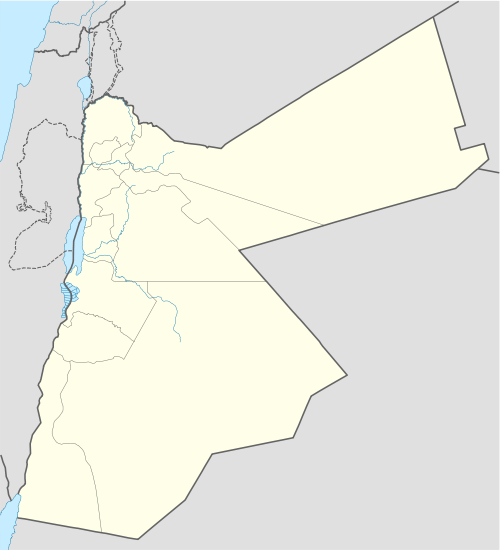This is a list of fortified buildings and complexes in Jordan from across all historical periods: forts, fortresses, castles, fortified palace complexes, caravanserais, pilgrims' inns, etc.
Some date to Roman times, or were built by the Crusaders in the 12th century. [1] Others were built by various Muslim dynasties and groups, such as the Umayyads, Abbasids, Ayyubids, Mamluks, Ottomans, and local tribal leaders.
A distinct group of fortified sites are the so-called desert castles, known from the entire region but particularly well represented in Jordan. What is known in English as a "desert castle" is known in Arabic as qaṣr (singular), quṣur being the plural in Arabic [2] (see here) and usually date to the Umayyad period. To make things complicated, not all Umayyad qasrs were built in the desert, 'qasr' may be used in Arabic for any type of fort or castle (but not in English-language academic literature), and certainly not all fortified places in the desert can be called desert castles in this sense.
List of castles in Jordan
| Name | Location | Picture | Notes |
|---|---|---|---|
| Ajloun Castle | Jordan |  |
Ajloun Castle ( Arabic: قلعة عجلون), transliterated: Qalʻat 'Ajloun; also Qalʻat ar-Rabad), is a 12th-century Muslim castle situated in northwestern Jordan. The castle was renovated in 1184 and it regulated traffic between Damascus and Egypt. [3] It is placed on a hilltop surrounded by a 15 meter deep moat and had seven towers. The castle was destroyed by Mongols in 1260, and subsequently rebuilt in the 17th century. [4] |
| Aqaba Fortress | Jordan |  |
The Aqaba Castle, Mamluk Castle or Aqaba Fort ( Arabic: قلعة العقبة, romanized: Qalʿat al-ʿAqaba), located in Aqaba, Jordan, is a fortress originally built by Crusaders in the 12th century, and named Helim. Ayla (ancient Aqaba) was recaptured by Saladin in 1187 and the fortress was destroyed, until it was rebuilt in the early 16th century under the Mamluk Sultan Al-Ashraf Qansuh Al-Ghuri. [5] The castle was captured by the Ottoman's in 1917. [6] |
| Kerak Castle | Jordan | 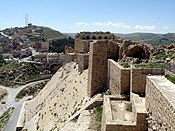 |
Kerak Castle ( Arabic: قلعة الكرك, romanized: Qal'at al-Karak) is a large Crusader castle located in al-Karak, Jordan. It was built by the Crusaders in the 12th century and it is situated high on a hilltop. [7] Construction of the castle began in the 1140s, under Pagan and Fulk, King of Jerusalem. The Crusaders called it Crac des Moabites [8] |
| Montreal (castle) | Arabah Valley, Jordan |  |
Montreal ( Arabic: مونتريال; Latin: Mons Regalis, Mont Real), or Qal'at ash-Shawbak (قلعة الشوبك) in Arabic, is a castle built by the Crusaders and expanded by the Mamluks, on the eastern side of the Arabah Valley. [9] |
| Qasr Al-Kharanah | Jordan |  |
Qasr Kharana ( Arabic: قصر خرّانة), sometimes Qasr al-Harrana, Qasr al-Kharanah, Kharaneh or Hraneh, is one of the best-known of the desert castles located in present-day eastern Jordan, about 60 kilometres (37 mi) east of Amman It is believed to have been built sometime before the early 8th century AD and consists of stone walls and large round corner towers. [10] |
| Qusayr 'Amra | Jordan |  |
Qusayr 'Amra or Quseir Amra, lit. "small qasr of 'Amra", sometimes also named Qasr Amra (قصر عمرة / ALA-LC: Qaṣr ‘Amrah), is the best-known of the desert castles located in present-day eastern Jordan. It was built some time between 723 and 743, by Walid Ibn Yazid, the future Umayyad caliph Walid II. [11] |
| Qasr Al-Mshatta | Jordan | 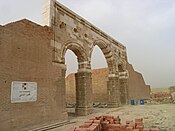 |
Qasr Mushatta ( Arabic: قصر المشتى, "Winter Palace") is the ruin of an Umayyad winter palace, probably commissioned by Caliph Al-Walid II during his reign (743-744). The castle is 144 square meters and it was used for ceremonies. [12] |
| Qasr Azraq | Jordan | 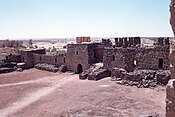 |
Qasr al-Azraq ( Arabic: قصر الأزرق, "Blue Fortress") is a large fortress located in present-day eastern Jordan. It is one of the desert castles, located on the outskirts of present-day Azraq, roughly 100 km (62 mi) east of Amman. [13] |
| Qasr al-Muwaqqar and Qasr al-Mushash | Jordan | Qasr al-Muwaqqar ( Arabic: قصر الموقر), and Qasr al-Mushash ( Arabic: قصر المشاش), were built in 723 AD, is the ruins of an Umayyad complex, the Qasr al-Muwaqqar, a qasr-type fortified palace also known as a desert castle. The original castles are mostly destroyed. [14] | |
| Qasr Bayir Castle | Jordan |  |
Qasr Bayir ( Arabic: قصر بيير), was constructed in 743 AD by Al-Walid II. It is found in the desert of Jordan and it was destroyed in 1931. [15] |
| Qasr Burqu | Jordan |  |
Qasr Burqu' ( Arabic: قصر برق), is a set of ruins and an archaeological site in the badia of eastern Jordan and is the site of one of the earliest of the Umayyad desert castles. [13] |
| Qasr Al-Qatraneh | Jordan |  |
Qasr Al-Qatraneh ( Arabic: قلعة القطرانة); alternatively: "Qatraneh" or "Qatrana Castle," "Fortress Qatrana," or "Khan Qatraneh") is an Ottoman structure which largely served to provide water and protection on the Syrian pilgrimage route between the Levant and the Gulf. It is located in modern-day Jordan. [16] [17] |
| Qasr Tuba | Jordan | 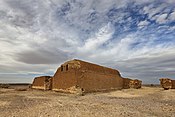 |
Qasr at-Tuba ( Arabic: قصر طوبا), is the southernmost of the Umayyad desert castles in Jordan. Built in 743 CE by Caliph al-Walid II for his sons, al-Hakam and ‘Uthman, [18] |
| Vaux Moise (Wu'ayra Castle) | Wadi Musa, Jordan | Vaux Moise, ( Arabic: فو مويس), also Li Vaux Moise or Alwaeira Castle (The Valley of Moses) is a small crusader castle close to Wadi Musa in Jordan. It was founded by Baldwin I of Jerusalem as an outpost of the larger crusader castle at Montreal. [1] |
See also
Map for castle locations
|
|---|
References
- ^ a b Kennedy, Hugh (1994). Crusader castles. Cambridge: Cambridge University Press. ISBN 978-0521799133.
- ^ Khouri, R.G., The Desert Castles: A Brief Guide to the Antiquities. Al Kutba, 1988. pp 4-5
- ^ Alhooti, A. T. (2016). Blue Blooded Tribesman. Singapore: Partridge. ISBN 978-1482855296. Retrieved 29 November 2021.
- ^ "Ajloun Castle". Lonely Planet. p. 25. Archived from the original on 29 November 2021. Retrieved 29 November 2021.
- ^ Clammer, Paul. "Aqaba Fort". Afar Magazine. AFAR Media. Archived from the original on 29 November 2021. Retrieved 29 November 2021.
- ^ Cotterell, Arthur (2017). The Near East : a cultural history. London: Hurst. ISBN 978-1849047968.
- ^ Birr, Nathan (2017). Blood and Treasure - the Douglas Files : book six. Boston, MA: Beacon. ISBN 978-0998181356.
- ^ Miller, Max (2020-01-15). Discover the Holy Land: A Travel Guide to Israel and Jordan. Wipf and Stock Publishers. ISBN 978-1-5326-6033-7. Archived from the original on 2021-11-29. Retrieved 2021-11-29.
- ^ Hourihane, Colum (2012). The Grove encyclopedia of medieval art and architecture. United Kingdom: Oxford University Press. ISBN 978-0195395365.
- ^ Deming, David (2010). Science and technology in world history. Volume 1, The ancient world and classical civilization. Jefferson, N.C.: McFarland & Co. p. 263. ISBN 978-0786458394. Retrieved 29 November 2021.
- ^ Qusayr 'Amra Archived 2021-11-28 at the Wayback Machine, World Monuments Fund, accessed 14 December 2019
- ^ "Qasr al-Mshatta". Arch Net. Archived from the original on 29 November 2021. Retrieved 29 November 2021.
- ^ a b Teller, Matthew (2016). The rough guide to Jordan (Sixth ed.). London: Rough Guides. p. 204. ISBN 978-0241250808. Archived from the original on 26 February 2022. Retrieved 29 November 2021.
- ^ "Qasr Muwaqqar". Nabataea. Nabataea.net. Archived from the original on 2 December 2021. Retrieved 2 December 2021.
- ^ "Qasr Bayir". The Sacred City. Archived from the original on 30 November 2021. Retrieved 30 November 2021.
-
^ Al Shqour, Reem Samed (2019).
The Aqaba Khans and the origin of khans in Jordan : an archaeological approach. Piscataway, NJ.
ISBN
978-1-4632-0651-2.
OCLC
1106116517.
Archived from the original on 2020-06-14. Retrieved 2021-11-29.
{{ cite book}}: CS1 maint: location missing publisher ( link) - ^ Al Shebli, Mohammad. "THE CONSERVATION AND RESTORATION OF AL- QATRANEH FORTRESS PROJECT." Presentation at the 14th International Conference on the History and Archaeology of Jordan (ICHAJ 14) in Florence, Italy. January, 2019. http://ichaj.org.10-0-0-4.mint.imagine.com.jo/content/abstracts Archived 2021-11-29 at the Wayback Machine
- ^ Hattstein, M. and Delius, P., Islam: Art and Architecture, Könemann, 2000. p. 72; Fowden, G., Qusayr 'Amra: Art and the Umayyad Elite in Late Antique Syria, University of California Press, 2004 p. 158
Further reading
- Jordan, Owen (2003). Jordan's Guide to British Castles and Fortifications (1st ed.). United Kingdom: King's England Press. ISBN 9781872438832.
- Sinclair, Susan (2012). Bibliography of Art and Architecture in the Islamic World. Vol. 2. The Netherlands: Brill. ISBN 978-9004170582.
